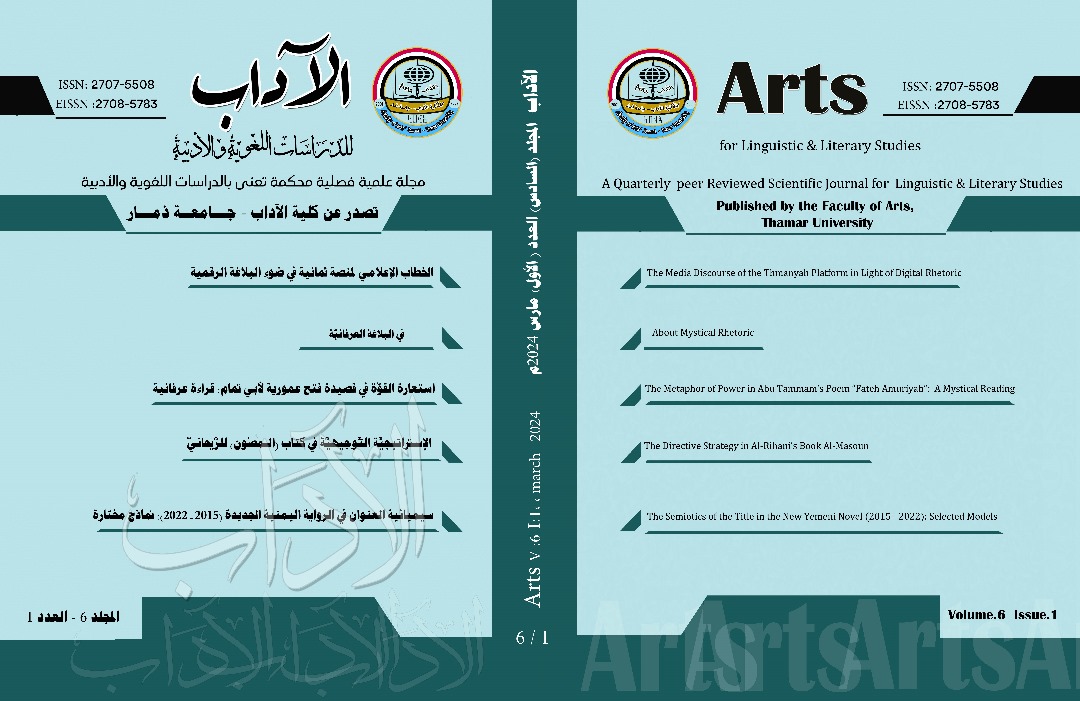The Metaphor of Power in Abu Tammam’s Poem “Fateh Amuriyah”: A Mystical Reading
DOI:
https://doi.org/10.53286/arts.v6i1.1778Keywords:
Mysticism, Conceptual Metaphor, Style, Saying, FrameworkAbstract
This research deals with the metaphors in Abu Tammam’s poem “Fateh Amuriyah” (The Conquest of Amuriyah) to reveal the major mental metaphor from which other verbal metaphors branched out, and which rhetorical and stylistic studies may be unable to do. The research selected the mystical studies, because of its interest in mental metaphors that appear in the expression. The research is divided into an introduction and three sections. The first section began by explaining the impact of the first recipient (The Praised Caliph) in creating these metaphors, as the Caliph was known to prefer force, which made Abu Tammam conform to the Caliph’s mentality and build his poem on a major metaphor, which is (Life is power). The second section dealt with the effect of the opening verses of the poem in revealing the great metaphor. This beginning established a major metaphor through the comparison between the sword and books and preferring the sword over books. The research demonstrated that this beginning is not - only - to be compatible with the occasion of the poem, but rather it is the product of a mentality that glorifies power and prefers it over science. Therefore, the research revealed partial metaphors that celebrate devastation in the third section. The research concluded that the metaphors in Abu Tammam’s poem relate to a mentality framed within the framework of power.
Downloads
References
البغدادي، الخطيب. (د.ت). تاريخ بغداد، المكتبة السلفية.
البوعمراني، محمد الصالح. (2015). الاستعارات التصورية وتحليل الخطاب السياسي (ط.1). كنوز المعرفة بالأردن.
البوعمراني، محمد الصالح. (2009). دراسات نظرية وتطبيقية في علم الدلالة العرفاني (ط.1). مكتبة علاء الدين.
التبريزي، الخطيب. (2007). شرح ديوان أبي تمام (راجي الأسمر، تحقيق)، دار الكتاب العربي.
التركي، إبراهيم. (2019). دراسات في البلاغة الإدراكية (ط.1). نادي القصيم الأدبي.
جاكندوف، راي. (2019). دليل ميسر إلى الفكر والمعنى (حمزة المزيني، مترجم ط.1)، كنوز المعرفة.
ابن خلكان، أحمد. (د.ت). وفيات الأعيان وأنباء أبناء الزمان، (إحسان عباس، تحقيق)، دار صادر.
الغذامي، عبد الله. (2008). النقد الثقافي (ط.4). المركز الثقافي العربي.
لايكوف، جورج، ومارك جونسن. (2009). الاستعارات التي نحيا بها (عبد المجيد جحفة، مترجم ط.2)، دار توبقال.
ابن منظور، محمد بن مكرم. (د.ت). لسان العرب، دار صادر.
Reference
al-Baghdādī, al-Khaṭīb. (N. D). Tārīkh Baghdād, al-Maktabah al-Salafīyah, (in Arabic).
al-Būʻamrānī, Muḥammad al-Ṣāliḥ. (2015). al-Istiʻārāt al-Taṣawrīyh & Taḥlīl al-Khiṭāb al-Siyāsī (1st Ed). Kunūz al-Maʻrifah bi-al-Urdun, (in Arabic).
al-Būʻamrānī, Muḥammad al-Ṣāliḥ. (2009). Dirāsāt Naẓarīyat & Taṭbīqīyah fī ʻilm al-Dalālah al-ʻirfānī (1st Ed). Maktabat ʻAlāʼ al-Dīn, (in Arabic).
al-Tabrīzī, al-Khaṭīb. (2007). Sharḥ Dīwān Abī Tammām (Rājī al-Asmar, taḥqīq), Dār al-Kitāb al-ʻArabī, (in Arabic).
al-Turkī, Ibrāhīm. (2019). Dirāsāt fī al-Balāghah al-Idrākīyah (1st ed.). Nādī al-Qaṣīm al-Adabī, (in Arabic).
Jackendoff, Ray. (2019). Dalīl Muyassar ilá al-Fikr & al-Maʻná (Ḥamzah al-Muzaynī, Tr. 1st Ed), Kunūz al-Maʻrifah, (in Arabic).
Ibn Khallikān, Aḥmad. (N. D). Wafīyāt al-Aʻyān & ʼAnbāʼ Abnāʼ al-Zamān, (Iḥsān ʻAbbās, taḥqīq), Dār Ṣādir, (in Arabic).
al-Ghadhāmī, ʻAbd Allāh. (2008). al-naqd al-Thaqāfī (4th ed.). al-Markaz al-Thaqāfyī al-ʻArabī, (in Arabic).
Lakoff, George, & Mark Johnson. (2009). al-Istiʻārāt allatī Naḥyā bi-hā (ʻAbd al-Majīd Jaḥfah, Tr. 2nd ed.), Dār Tūbqāl, (in Arabic).
Ibn Manẓūr, Muḥammad ibn Mukarram. (N. D). Lisān al-ʻArab, Dār Ṣādir, (in Arabic).
Downloads
Published
How to Cite
Issue
Section
License

This work is licensed under a Creative Commons Attribution 4.0 International License.
Copyright and Licensing
copyright is retained by the authors. Articles are licensed under an open access Creative Commons CC BY 4.0 license, meaning that anyone may download and read the paper for free. In addition, the article may be reused and quoted provided that the original published version is cited. These conditions allow for maximum use and exposure of the work.



